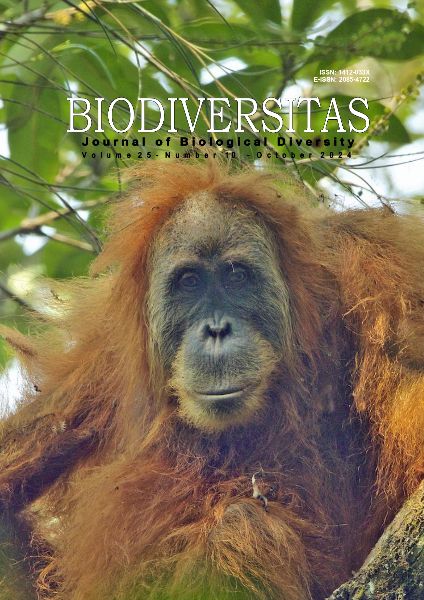Phenotype variability of Pometia pinnata from Riau, Indonesia based on qualitative characters
##plugins.themes.bootstrap3.article.main##
Abstract
Abstract. Zulfahmi, Rosmaina. 2024. Phenotype variability of Pometia pinnata from Riau, Indonesia based on qualitative characters. Biodiversitas 25: 3953-3964. Matoa (Pometia pinnata J.R.Forst. & G.Forst.) is an important underutilized fruit tree in Riau Province, Indonesia. Information on the genetic diversity of P. pinnata is poorly reported. This study aimed to estimate the phenotype variability of P. pinnata in Riau Province, Indonesia based on qualitative characters. Twenty-seven qualitative characters were used to study the phenotype variability of 24 P. pinnata genotypes. The diversity for each character was calculated using the Shannon-Weaver Index and cluster analysis among genotypes was constructed by an Unweighted Pair Group Method with Arithmetic Average (UPGMA). The results showed a high variability in almost all the characters observed. The estimated value of the Shannon-Weaver Index of P. pinnata ranged from 0.00-0.980. Eighteen characters exhibited a high diversity level (0.67-0.98), two characters demonstrated an intermediate level (0.41-0.66), and the remaining had low diversity (0.00-0.25). A dendrogram grouped 24 P. pinnata into four main clusters, i.e. black-skinned P. pinnata and green-skinned P. pinnata, yellow-skinned P. pinnata, red-skinned P. pinnata, and red-skinned P. pinnata. In general, P. pinnata was grouped based on the color of the ripe fruit skin, which indicated that fruit color characters play an important role in P. pinnata diversity. The ripe skin color can be used as the specific character to differentiate among P. pinnata genotypes easily. This information can be utilized for P. pinnata improvement and breeding in the future.


 http://orcid.org/0000-0001-6146-9919
http://orcid.org/0000-0001-6146-9919